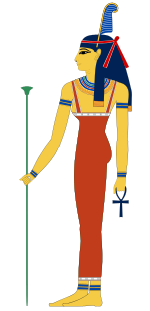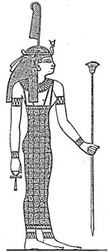Maat (Egyptian mythology)
| Maat in hieroglyphics | |||||||
|---|---|---|---|---|---|---|---|
| ideogram |
|
||||||
| Old empire |
|
||||||
|
|||||||
|
|||||||
| Middle realm |
|
||||||
| New kingdom |
|
||||||
|
|||||||
| String time |
Maat M3ˁt Maat |
||||||
| Mate | |||||||
Maat was the ancient Egyptian concept of justice , world order , truth , governance and law . It was embodied by an ancient Egyptian goddess, documented since the Old Kingdom . She was considered the daughter of Re and appeared among other things in her appearance of the Tefnut as the eye of Re .
etymology
Maat stands as a word for a principle . An appropriate translation of the term into German is not possible, as individual words such as justice ( Coptic me, mei ), truth or world order only reflect one aspect.
The term Maat coincided with the development of the Egyptian state system. It appears for the first time in personal names of the Thinnite period such as Nimaathapi , and since the 5th Dynasty it has also been used outside of names.
The term “Maat” represents the conventional spelling in Egyptology , with the consonants 3ˁ being reproduced as aa . The original vocalization was derived from the various names of the kings ( pharaohs ) in cuneiform tradition as Mu3ˁat ; for example for Amenhotep III. by ni-ib- mu-a -ri / ea for the throne name "Neb-maat-Re".
The verb m3ˁ relates on the one hand to the meanings of “direct”, “direct” and “give things a direction” and on the other hand to “offer” and “sacrifice”. These meanings result in translations that are related to the subject of the “sense of direction”, whereby this should be understood as the “correct direction including the truth”.
Maat as a goddess
Maat was later personified as a goddess of Egyptian mythology . Depicted as a woman with an ostrich feather on her head and an ankh in her hand, she symbolizes the moral world order. Maat first appears as a subordinate term or deity in the legends about Re and only later emerged as an independent deity. That is possibly one reason why she is not represented in the divine Ninth .
The term Maa.tj , "the two Maat" , also appears often . Attempts to assign such as one for the inner and one for the outer order could not prevail in research. The origin of this doubling is also not clear.
The mate was later assigned a sister named Isfet as the opposite pole, who stands for chaos . Although Isfet is feared because it brings suffering and devastation, its very existence is not called into question as both aspects , the positive and the negative, must be present for a balance to exist.
Development of the concept of God
Maat in relation to other gods
- Maat as companion of the Re
- She accompanies him on the journey in the sun barge ( pyramid texts ).
- Maat later became the daughter of Re
- As an order from the beginning, the God given Maat comes from the Creator God , Re . Accordingly, the personification of Maat as goddess first arose in a subordinate relationship to him. The Maat as goddess is also known as Ka des Re. Due to her function as a donor of life force for Re, she is sometimes referred to in later ritual texts as the “mother of Re”.
- Maat in equation with Uraeus and the eye of the sun
- "... it is united with your head" (means the Uraeus ), "Your right eye is Maat, your left eye is Maat".
- Maat as wife of Thoth
- The marriage with Thoth , the vizier of the sun god Re, is supposed to symbolize the connection between Thoth and Maat. Thoth later became responsible for the execution of the decisions of the sun god, which refer to Maat and are based on her.
- Maat as the successor of Thoth
- in the first dynasty of gods, handed down by the royal papyrus Turin .
Cultic connections
- Administration of justice
- "Police" interrogations took place in places of worship of the Maat; prisoners on remand were also kept in them. High judges wore pectorals with the image of the goddess; this should possibly mark them as the priest of the mate.
- Afterlife goddess
- Due to the importance of the mate in the judgment of the dead , she later becomes a kind of goddess of the dead. Around the Middle Kingdom she was given the nickname "Lady of the West", and occasionally also "Lady of the North Wind". Necropolises , e.g. B. the Theban, were referred to as the "(residential) seat of the mate".
- Merging with other goddesses
- The sanctuaries of the Maat were mostly attached to larger sanctuaries of other goddesses, e.g. B. Hathor or Isis . In the later period it came to a merger.
Maat as a world order
Maat also denotes the principle of the cosmological order. Only thanks to Maat does the sun rise and only thanks to her is life possible. In this sense, Maat denotes not only the ideal of the world that is striven for , but in a certain way its current state. The basis of the Maat principle was the idea that the divine community exists as a reflection of the earthly world order on the cosmological level. The king therefore received the divine commission to realize this cosmological order on earth through kingship:
“Re has instituted the king on the earth of the living forever and ever in the justice of the people, in the gratification of the gods, in the creation of the mate, in the destruction of the Isfet. He (the king) gives sacrifices from God to the gods and sacrifices to the dead of the transfigured. The name of the king is in heaven like (that of) Re. "
Maat is not just an immutable state, however. Human behavior can throw the scales out of balance and Isfet, that is, chaos and destruction, comes over the earth. For this reason, the most important thing is to keep the Maat going. The Maat is not a written code of rules and regulations, but rather a concept. The laws of the Maat have certainly changed over time, but are only indirectly preserved. From grave inscriptions containing the contents of the Egyptian Book of the Dead , the understanding of the Maat principle from the point of view of the king's subordinates becomes clear:
“I did you mate when I was on earth because I was aware that you lived off her. I am the excellent one who pleases his God well, I am aware that he judges hearts and that he lives from his mate. I did mate for the Lord of the two countries at night as during the day, because I was aware that he lives from her; "
The world order of the Maat had its heyday as a fixed scheme of action from the Old Kingdom to the end of the Second Intermediate Period . With the beginning of the New Kingdom and the introduction of the Book of the Dead , the first changes in the classical perspective began. The personal piety that developed in the further course contradicted the principle of the actual Maat principle, which was based on the principle of equality instead of individual needs.
Getting the mate
The mate had to be cared for by a complicated network: on the one hand, the king ( Pharaoh ) had the task of maintaining the world order through secret rituals and his behavior. On the other hand, every Egyptian, regardless of their status, had to submit to the rules of the mate. Otherwise he brought chaos and destruction, if not over the whole country, then at least over his own fate.
These behaviors are religiously motivated, but they affect all areas of life. However, this makes it difficult to assign them exactly. For example, the wisdom teachings of Ptahhotep or Khnumhotep offer a point of reference, but grave texts such as the negative confession of sins also provide information.
Maat in the judgment of the dead
The underground courtroom of the judgment of the dead , the representation of which is so often found in the papyrus scrolls , is named after her Maa.tj ("hall of the two truths", i.e. the truth or justice that saves and those who damn).
The pen of the mate is particularly important for a dead person who has to justify his life before the judgment of the gods ( presided over by Osiris ). In this judgment of the dead , the heart of the deceased is weighed against the pen of the mate, which symbolizes truth and order. Only a person who fully passed the negative confession of guilt could step into the enlightened places of the Duat . The designations for the deceased, “justified” or “true in voice” ( Maa-cheru ), testify to the importance of the mate.
See also
literature
- Jan Assmann : Ma'at. Justice and Immortality in Ancient Egypt. 2nd edition, Beck, Munich 1995, ISBN 3-406-39039-0 .
- Claas Jouco Bleeker: De beteekenis van de egyptische godin Ma-at. IJdo, Leiden 1929 (Leiden, Univ., Diss., 1929).
- Hans Bonnet : Maat. In: Hans Bonnet: Lexicon of the Egyptian religious history. 3rd, unchanged edition, Nikol, Hamburg 2000, ISBN 3-937872-08-6 , pp. 430-434.
- Wolfgang Helck , Eberhard Otto (Ed.): Maat. In: Small Lexicon of Egyptology. 4th, revised edition, Harrassowitz, Wiesbaden 1999, ISBN 3-447-04027-0 , p. 176 f.
- Gabriele Höber-Kamel (Ed.): The principle of the Maat (= Kemet issue 2/2012 ). Kemet-Verlag, Berlin 2012, ISSN 0943-5972 .
- Miriam Lichtheim : Maat in Egyptian Autobiographies and Related Studies. Universitätsverlag / Vandenhoeck & Ruprecht, Freiburg, Switzerland / Göttingen 1992, ISBN 3-7278-0846-2 .
- Emily Teeter: ma'at. In: Kathryn A. Bard (Ed.): Encyclopedia of the Archeology of Ancient Egypt. Routledge, London 1999, ISBN 0-415-18589-0 , pp. 458-60.
Web links
- Joachim Friedrich Quack: Maat. In: Michaela Bauks, Klaus Koenen, Stefan Alkier (eds.): The scientific biblical lexicon on the Internet (WiBiLex), Stuttgart 2006 ff., Accessed on May 26, 2012.
Remarks
- ↑ The original hieroglyph cannot be represented in the Wikipedia font. Instead of the male god Ptah , a standing female mummy with the Maat feather on her head can be seen.
Individual evidence
- ↑ Gabriele Höber-Kamel: Maat - life principle and divine norm. in: Kemet issue 2/2012. , P. 5.
- ^ Miriam Lichtheim: Maat in Egyptian Autobiographies and Related Studies. Freiburg, Switzerland / Göttingen 1992, p. 18.
- ↑ a b Jan Assmann: Ma'at. Justice and Immortality in Ancient Egypt. Munich 1995, p. 15.
- ^ A b Hans Bonnet: Maat. Hamburg 2000, p. 433.
- ↑ Jan Assmann: Ma'at. Justice and Immortality in Ancient Egypt. Munich 1995, p. 206.
- ↑ Jan Assmann: Ma'at. Justice and Immortality in Ancient Egypt. Munich 1995, p. 212.
- ↑ Jan Assmann: Ma'at. Justice and Immortality in Ancient Egypt. Munich 1995, p. 10.


